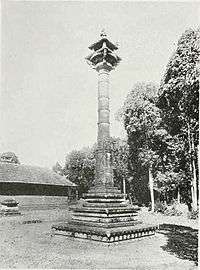South Canara
| South Canara | |
|---|---|
| district of British India | |
 | |
| Coordinates: 13°00′N 75°24′E / 13.00°N 75.40°ECoordinates: 13°00′N 75°24′E / 13.00°N 75.40°E | |
| Country |
|
| State | Karnataka |
| Area | |
| • Total | 8,441 km2 (3,259 sq mi) |
| Population (2001)[1] | |
| • Total | 3,005,897 |
| • Density | 356.1/km2 (922/sq mi) |
| Languages | |
| • Languages | Kannada |
| Time zone | UTC+5:30 (IST) |
| ISO 3166 code | [[ISO 3166-2:IN|]] |
| Vehicle registration | KA-19, KA-20, KA-21, KA-62, KL-14 |
| Largest city | Udupi |
South Canara was a district of the Madras Presidency of British India, located at 13°00′N 75°24′E / 13.00°N 75.40°E.[2] It covered the areas of the present-day districts of Dakshina Kannada and Udupi of Karnataka and the Kasaragod District of Kerala. The district was one of the most heterogeneous of Madras Presidency with Tulu, Malayalam , Kannada, Konkani and Beary being the principal languages spoken. It was succeeded by Dakshina Kannada in 1947.
South Kanara was annexed by the British East India Company following the defeat of Tipu Sultan in the Fourth Mysore War 1799 and along with North Kanara formed the district of Kanara in the Madras Presidency. In 1859, Kanara was split into two districts, North and South. North Kanara was transferred to the Bombay Presidency, and South was retained by Madras. Mangalore was the administrative headquarters of the district. The district covered an area of 10,410 square kilometres (4,021 sq mi).
Taluks

The district was divided into six taluks:
- Amindivi Islands (Laccadives) (Area:7.8 square kilometres (3 sq mi))
- Coondapoor (Area:1,600 square kilometres (619 sq mi); Headquarters: Coondapoor)
- Kasaragod (Area:1,970 square kilometres (762 sq mi); Headquarters: Kasaragod)
- Mangalore (Area:1,760 square kilometres (679 sq mi); Headquarters: Mangalore)
- Udupi (Area:1,860 square kilometres (719 sq mi); Headquarters: Udupi)
- Uppinangady (Area:3,210 square kilometres (1,239 sq mi); Headquarters: Puttur)
Administration
The district was administered by a District Collector. For purpose of convenience, the district was divided into three sub-divisions:
- Coondapoor sub-division: Coondapoor and Udupi taluks
- Mangalore sub-division: Mangalore, and the Amindivi islands
- Puttur sub-division: Uppinangady and Kasaragod taluks.
The district had two municipalities, those of Mangalore and Udupi.
Demographics
| Historical population | ||
|---|---|---|
| Year | Pop. | ±% |
| 1871 | 918,362 | — |
| 1881 | 959,514 | +4.5% |
| 1891 | 1,056,081 | +10.1% |
| 1901 | 1,134,713 | +7.4% |
| Source: Imperial Gazetter of India, Volume 14[3] | ||

South Kanara had a total population of 1,134,713 in 1901, of whom 81 percent were Hindus, 11 percent Muslim and 7 percent Christian. In 1901, South Kanara had a density of 109 inhabitants per square kilometre (282/sq mi).
The 1908 Imperial Gazetteer of India lists South Canara, along with the Thanjavur and Ganjam districts, as the three districts of the Madras Presidency where Brahmins are most numerous.[3]
The majority of the people were Billavas, Bunts. There were more Brahmins (12% of the population) in South Kanara than any other district of the Madras Presidency making South Kanara, along with Tanjore and Ganjam as one of the three districts of the province where Brahmins were most numerous.[3]
The original Indigenous people of the region are Tuluvas (Bunts, Billavas, Mogaveeras, Kulalas, Devadigas).The Brahmins who settled first belonged chiefly to the Sthanika and thus they were called as Tulu Brahmins. Others were Shivalli, Saraswat, Havyaka, Kotaha sub-sections, Mahars, the hill-tribes (Koragas).[4]
See also
References
- ↑ "Census GIS India". Census of India. Archived from the original on 11 January 2010. Retrieved 26 March 2008.
- ↑ Patsy Lozupone, Bruce M. Beehler, Sidney Dillon Ripley.(2004).Ornithological gazetteer of the Indian subcontinent, p. 82.Center for Applied Biodiversity Science, Conservation International. ISBN 1-881173-85-2.
- 1 2 3 The Imperial Gazetteer of India. 14. Clarendon Press. 1908.
- ↑ Silva, Severine; Fuchs, Stephan (1965). "The Marriage Customs of the Christians in South Canara, India". Asian Folklore Studies. Nanzan University. 24 (2): 2–3.
External links
- South Canara by Vikas Kamat from Kamat.com
| Look up South Canara in Wiktionary, the free dictionary. |